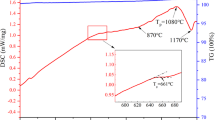Abstract
The chlorination−volatilization process has been adopted to make full use of gold-bearing and iron-rich pyrite cinder. However, problems of low recovery rate, pulverization of pellets, and ring formation have been encountered during the industrialization of this process. The effects of various parameters on the volatilization rates of valuable metals and on the compressive strength of roasted pellets were investigated in this paper. The parameters include the CaCl2 dosage, heating temperature, and holding time. The results show that heating temperature is the most important parameter for the recovery of target metals. More CaCl2 was needed for the recovery of zinc than for the recovery of gold, silver, and lead. CaCl2 started to react with sulfides/SO2/SiO2 at temperatures below the melting point of CaCl2 to generate Cl2/HCl. Gaseous CaCl2 was formed at higher temperatures and could react with any of the components. The compressive strength of roasted CaCl2-bearing pellets first decreased slowly with increasing temperature at temperatures lower than 873 K, which could result in the pulverization of pellets during heating. Their compressive strength increased dramatically with increasing temperature at temperatures greater than 1273 K. Certain quantities of CaCl2 and Fe(II) could improve the compressive strength of the roasted pellets; however, the addition of excessive CaCl2 decreased the compressive strength of pellets.
Similar content being viewed by others
References
T. Li, Y.F. Yin, X.H. Fang, and T.S. Qiu, Technological status of recovering copper, lead, zinc, sulfur from gold cyaniding tailings, Mod. Min., (2011), No. 4, p. 28.
C.C. Lv, J. Ding, P. Qian, Q.C. Li, S.F. Ye, and Y.F. Chen, Comprehensive recovery of metals from cyanidation tailing, Miner. Eng., 70(2015), p. 141.
A.C. Lin, Balance research on harmful element in ironmaking process in Honghe steel, Yunnan Metall., 42(2013), No. 4, p. 39.
D.G. Tang, Research on pyrite cinder used in pellet production, China Resour. Compr. Util., 24(2006), No. 7, p. 5.
X.Q. Sun, Z.S. Yao, J. Jin, and Y. Wu, Experimental feasibility study on production of oxidized agglomerate by utilization of SA cinder, Phosphate Compd. Fert., 2005, No. 6, p. 13.
D.Q. Zhu, T.J. Chun, J. Pan, and Z.Q. Guo, Preparation of oxidised pellets using pyrite cinders as raw material, Ironmaking Steelmaking, 40(2013), No. 6, p. 430.
B.S. Hu and H. Wang, The transition of occurrence of copper, gold and silver in Tongling pyrite cinder during magnetic roasting and separation, Multipurpose Util. Miner. Resour., 2002, No. 2, p. 16.
Y.L. Li, W.S. Guan, X.D. Shi, Q. Wang, and S.Q. Li, Research advances in the reclamation of gold and silver from pyrite slag, Appl. Chem. Ind., 38(2009), No. 11, p. 1671.
J.T. Wei, B.K. Guo, G.Y. Yan, and X.J. Zhen, Study on recovering gold from pyrite cinder by superfine grinding-resin-in-pulp method, Gold, 23(2002), No. 4, p. 34.
D.M. Gao and C.L. Lv, Study on gold extraction from gold-bearing sulfuric-acid slag by the process of chlorine leaching, Gold Sci. Technol., 13(2005), No. 6, p. 17.
L.S. Strizhko, R.I. Normurotov and D.B. Kholikulov, Investigations into extracting gold from gold-containing magnesium fraction by chlorination, Russ. J. Non-Ferrous Met., 50(2009), No. 4, p. 348.
J.K.S. Tee and D.J. Fray, Separation of copper from steel, Ironmaking Steelmaking, 33(2006), No. 1, p. 19.
F. Santos, E. Brocchi, V. Araújo, and R. Souza, Behavior of Zn and Fe content in electric arc furnace dust as submitted to chlorination methods, Metall. Mater. Trans. B, 46(2015), No. 4, p. 1729.
J. Ding, J.W. Sun, P. Qian, Z.K. Pan, S.F. Ye, Q.C. Li, C.X. Wang, and Y.F. Chen, Experimental study on recovering valuable metals from pyrite cinder by chloridizing roast, Comput. Appl. Chem., 29(2012), No. 3, p. 255.
A. Landsberg and C.L. Hoatson, The kinetics and equilibria of the gold-chlorine system, J. Less Common Met., 22(1970), No. 3, p. 327.
P.G. Jiang, P.F. Wu, Z.B. Wang, Y.B. Yan, and Q.X. Jing, Research progress of chloridizing volatilization, Nonferrous Met. Sci. Eng., 7(2016), No. 6, p. 43.
T. Guo, X.J. Hu, H. Matsuura, F. Tsukihashi, and G.Z. Zhou, Kinetics of Zn removal from ZnO−Fe2O3−CaCl2 system, ISIJ Int., 50(2010), No. 8, p. 1084.
T. Guo, X.J. Hu, X.M. Hou, H. Matsuura, F. Tsukihashi, and G.Z. Zhou, Chlorination reaction mechanism between ZnFe2O4 and CaCl2, J. Univ. Sci. Technol. Beijing, 33(2011), No. 4, p. 474.
L.I. Barbosa, J.A. González, and M. del CarmenRuiz, Extraction of lithium from β-spodumene using chlorination roasting with calcium chloride, Thermochim. Acta, 605(2015), p. 63.
D.Q. Zhu, D. Chen, J. Pan, and G.L. Zheng, Chlorination behaviors of zinc phases by calcium chloride in high temperature oxidizing-chloridizing roasting, ISIJ Int., 51(2011), No. 11, p. 1773.
L. Jian, S.M. Wen, C. Yu, D. Liu, S.J. Bai, and D.D. Wu, Process optimization and reaction mechanism of removing copper from an Fe-rich pyrite cinder using chlorination roasting, J. Iron Steel Res. Int., 20(2013), No. 8, p. 20.
G.Y. Fu, J. Ding, L.Q. Wei, X.M. Zhang, Y. Liu, and S.F. Ye, Study on the corrosion and adhesion behavior of chloridizing metallurgy furnace, Gold Sci. Technol., 23(2015), No. 5, p. 99.
G. Fraissler, M. Jöller, T. Brunner, and I. Obernberger, Influence of dry and humid gaseous atmosphere on the thermal decomposition of calcium chloride and its impact on the remove of heavy metals by chlorination, Chem. Eng. Process., 48(2009), No. 1, p. 380.
X.L. Wang, Ferrous Metallurgy (Ironmaking Section), Metallurgical Industry Press, Beijing, 2013, p. 41.
T. Jiang, Production Manual of Sintering and Pelletizing, Metallurgical Industry Press, Beijing, 2014, p. 169.
Acknowledgements
This work financially supported by the National Natural Science Foundation of China (No. 51202249), the National High-Tech Research and Development Program of China (No. 2011AA06A104), and the Projects in the National Science & Technology Pillar Program during the 12th Five-year Plan Period (No. 2012BAB08B04).
Author information
Authors and Affiliations
Corresponding author
Rights and permissions
About this article
Cite this article
Ding, J., Han, Pw., Lü, Cc. et al. Utilization of gold-bearing and iron-rich pyrite cinder via a chlorination–volatilization process. Int J Miner Metall Mater 24, 1241–1250 (2017). https://doi.org/10.1007/s12613-017-1516-0
Received:
Revised:
Accepted:
Published:
Issue Date:
DOI: https://doi.org/10.1007/s12613-017-1516-0




